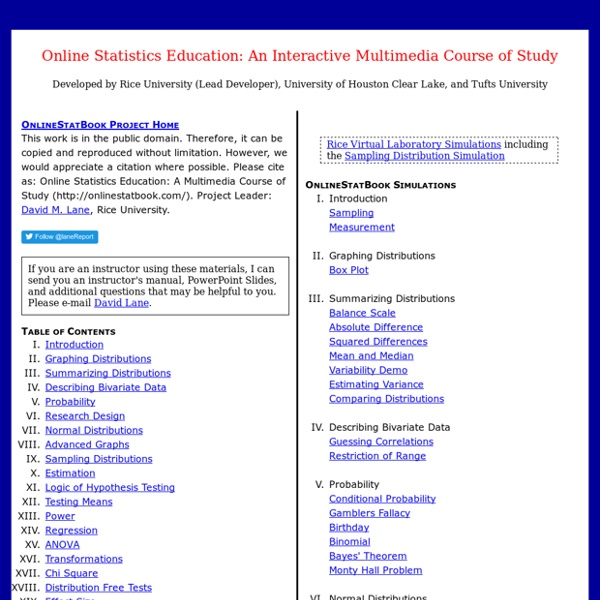D - Likert Scales and Data Analyses
by I. Elaine Allen and Christopher A. Seaman Surveys are consistently used to measure quality.
Menu
OpenEpi provides statistics for counts and measurements in descriptive and analytic studies, stratified analysis with exact confidence limits, matched pair and person-time analysis, sample size and power calculations, random numbers, sensitivity, specificity and other evaluation statistics, R x C tables, chi-square for dose-response, and links to other useful sites. OpenEpi is free and open source software for epidemiologic statistics. It can be run from a web server or downloaded and run without a web connection. A server is not required. The programs are written in JavaScript and HTML, and should be compatible with recent Linux, Mac, and PC browsers, regardless of operating system.
HyperStat Online: An Introductory Statistics Textbook and Online Tutorial for Help in Statistics Courses
Recommend HyperStat to your friends on Facebook Click here for more cartoons by Ben Shabad. Other Sources Stat Primer by Bud Gerstman of San Jose State University
Introduction to Probability - Open Textbook Library
This text provides very good coverage of the essential topics for an introductory probability course in addition to its coverage of topics that I’m sure are left out of some introductory courses such as Markov processes and generating functions. The strength of this book in my view (which is from an engineering perspective) is that it approaches topics in a very natural way, using practical examples, simple graphics, and discussion of computer simulation when introducing topics. It does not seem to burden the reader with statistical jargon or needlessly deep discussions of theory, but it does not give the impression that it is trying to avoid these things either.
D - Statistical Analysis and Research Methodology
Statistical analysis is fundamental to all experiments that use statistics as a research methodology. Most experiments in social sciences and many important experiments in natural science and engineering need statistical analysis. Statistical analysis is also a very useful tool to get approximate solutions when the actual process is highly complex or unknown in its true form. Example: The study of turbulence relies heavily on statistical analysis derived from experiments. Turbulence is highly complex and almost impossible to study at a purely theoretical level.
The Central Limit Theorem
To understand the wildness of samples, we would choose thousands of samples, calculate an x-bar for each, and display the x-bars in a histogram. This histogram represents a sampling distribution and when we look at it we see something truly amazing. Sampling distributions tend to be far less variable or wild than the populations they are drawn from (See Fig. 1A, 1B, 1C and 1D.)
Complimentary Exam Copies
Please read the terms and conditions carefully before completing the form. To ensure that your request is processed quickly, please complete the required fields in the form below. eInspections – Save Time & The Environment Alternatively we can now offer many of our titles for inspection online. If you would like to inspect our books via this innovative, student-friendly format, simply select this option in the following form, give your full course details and, upon authorization, you will then be able to view the book from any PC with Internet access. Furthermore you will be able to annotate and highlight parts of the book and share the online edition with your colleagues. Terms and Conditions
MATH 146 – Introduction to Statistics
In this course, we will introduce some of the more common tools for analyzing data of several types. We are not aiming at introducing all or even most of them. The main goal of the course is to highlight the general assumptions and methods that underlie all statistical analysis. The purpose is to get a good understanding of the scope, and the limitations of these methods. We also want to learn as much as possible about the assumptions behind the most common methods, in order to evaluate if they apply with reasonable accuracy to a given situation.
D - Odds Are, It's Wrong
For better or for worse, science has long been married to mathematics. Generally it has been for the better. Especially since the days of Galileo and Newton, math has nurtured science. Rigorous mathematical methods have secured science’s fidelity to fact and conferred a timeless reliability to its findings.
Sample Size Calculator - Confidence Level, Confidence Interval, Sample Size, Population Size, Relevant Population - Creative Research Systems
This Sample Size Calculator is presented as a public service of Creative Research Systems survey software. You can use it to determine how many people you need to interview in order to get results that reflect the target population as precisely as needed. You can also find the level of precision you have in an existing sample. Before using the sample size calculator, there are two terms that you need to know. These are: confidence interval and confidence level.



